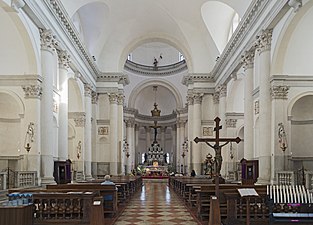
The Doge's Palace is a palace built in Venetian Gothic style, and one of the main landmarks of the city of Venice in northern Italy. The palace was the residence of the Doge of Venice, the supreme authority of the former Republic of Venice. It was built in 1340 and extended and modified in the following centuries. It became a museum in 1923 and is one of the 11 museums run by the Fondazione Musei Civici di Venezia.

Andrea Palladio was an Italian Renaissance architect active in the Venetian Republic. Palladio, influenced by Roman and Greek architecture, primarily Vitruvius, is widely considered to be one of the most influential individuals in the history of architecture. While he designed churches and palaces, he was best known for country houses and villas. His teachings, summarized in the architectural treatise, The Four Books of Architecture, gained him wide recognition.

The Grand Canal is a channel in Venice, Italy. It forms one of the major water-traffic corridors in the city.
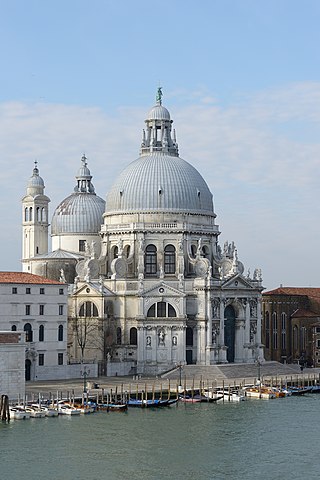
Santa Maria della Salute, commonly known simply as the Salute, is a Roman Catholic church and minor basilica located at Punta della Dogana in the Dorsoduro sestiere of the city of Venice, Italy.

Baldassare Longhena was an Italian architect, who worked mainly in Venice, where he was one of the greatest exponents of Baroque architecture of the period.

The Gallerie dell'Accademia is a museum gallery of pre-19th-century art in Venice, northern Italy. It is housed in the Scuola della Carità on the south bank of the Grand Canal, within the sestiere of Dorsoduro. It was originally the gallery of the Accademia di Belle Arti di Venezia, the art academy of Venice, from which it became independent in 1879, and for which the Ponte dell'Accademia and the Accademia boat landing station for the vaporetto water bus are named. The two institutions remained in the same building until 2004, when the art school moved to the Ospedale degli Incurabili.

The Festa del Redentore is an event held in Venice the third Sunday of July where fireworks play an important role.

San Giorgio Maggiore is a 16th-century Benedictine church on the island of the same name in Venice, northern Italy, designed by Andrea Palladio, and built between 1566 and 1610. The church is a basilica in the classical Renaissance style and its brilliant white marble gleams above the blue water of the lagoon opposite the Piazzetta di San Marco and forms the focal point of the view from every part of the Riva degli Schiavoni.

Santa Maria del Rosario, commonly known as I Gesuati, is an 18th-century Dominican church in the Sestiere of Dorsoduro, on the Giudecca canal in Venice, northern Italy. The classical style building has a well-lit interior and is exceptional in preserving its original layout and Rococo decoration intact. The church and almost all its sculpture and paintings were created within a thirty-year period: construction began in 1725, the church was consecrated in 1743, and the last sculptural decoration was in place by 1755.

San Francesco della Vigna is a Roman Catholic church in the Sestiere of Castello in Venice, northern Italy.

Le Zitelle is a church in Venice, Italy. It is part of a former complex which gave shelter to young maidens who had no dowry, and is in the easternmost part of the Giudecca island.

Marco Antonio Bassetti (1586–1630) was an Italian painter.
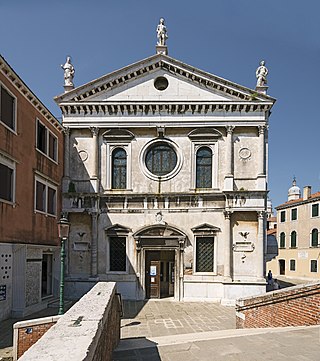
The Chiesa di San Sebastiano is a 16th-century Roman Catholic church located in the Dorsoduro sestiere of the Italian city of Venice. The church houses a cycle of paintings by the artist Paolo Veronese, as well as paintings by Tintoretto and Titian. The church is also a member of the Chorus Association of Venetian churches. It stands on the Campo di San Sebastiano by the Rio di San Basilio, close to the Giudecca Canal. It is one of the five votive churches in Venice, each one built after the passing of a plague through the city. Following construction, the church was dedicated to a saint associated with the disease; in this case St. Sebastian.
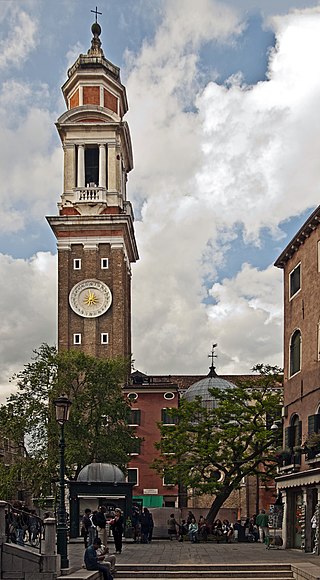
The Chiesa dei Santi Apostoli di Cristo, commonly called San Apostoli, is a 7th-century Roman Catholic church located in the Cannaregio sestiere of the Italian city of Venice. It is one of the oldest churches in the city and has undergone numerous changes since its foundation. The present building is the result of a major reconstruction project which was undertaken in 1575. The church is notable particularly for the Cornaro Chapel, an important example of Early Renaissance architecture, added by Mauro Codussi during the 1490s. The chapel is the burial place of several members of the powerful Cornaro family, including Catherine Cornaro, Queen of Cyprus and Armenia. The church houses several works of art including pieces by Giambattista Tiepolo and Paolo Veronese.

The Basilica di San Pietro di Castello, commonly called San Pietro di Castello, is a Roman Catholic minor basilica of the Patriarch of Venice located in the Castello sestiere of the Italian city of Venice. The present building dates from the 16th century, but a church has stood on the site since at least the 7th century. From 1451 to 1807, it was the city's cathedral church, though hardly playing the usual dominant role of a cathedral, as it was overshadowed by the "state church" of San Marco and inconveniently located. During its history, the church has undergone a number of alterations and additions by some of Venice's most prominent architects. Andrea Palladio received his first commission in the city of Venice from the Patriarch Vincenzo Diedo to rebuild the facade and interior of St Pietro, but Diedo's death delayed the project.

The church of Santa Maria Assunta, known as I Gesuiti, is a religious building in Venice, northern Italy. It is located in the sestiere of Cannaregio, in Campo dei Gesuiti, not far from the Fondamenta Nuove.
The Feast of the Most Holy Redeemer was a Catholic liturgical feast. It is celebrated in Venice as the Festa del Redentore. It is also celebrated by the Redemptorists and was celebrated in the City of Rome.

Santa Corona is a Gothic-style, Roman Catholic church located in Vicenza, region of Veneto, Italy. The church contains the Valmarana chapel, whose design is attributed to the Renaissance architect Andrea Palladio. Palladio himself was initially buried in this church.
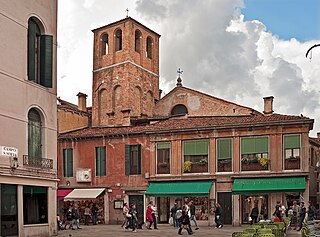
Santa Sofia is a church located in the sestiere (neighborhood) of Cannaregio in Venice, Italy. It should be distinguished from the palazzo Ca' d'Oro on the Grand Canal is also called the Palazzo Santa Sofia.

The Giudecca Canal is a body of water that flows into the San Marco basin in Venice, Italy.


